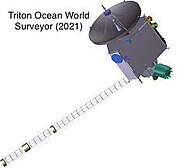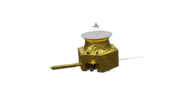Exploration of Neptune

Since the mid-1990s, Neptune has been studied from afar with telescopes, including the
Voyager 2
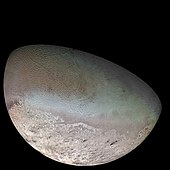
After Voyager 2 visited Saturn successfully, it was decided to fund further missions to Uranus and Neptune. These missions were conducted by the Jet Propulsion Laboratory, and the Neptunian mission was dubbed "Voyager Neptune Interstellar Mission". Voyager 2 started taking navigation images of Neptune in May 1988.[3] Voyager 2's observation phase proper of Neptune began 5 June 1989, the spacecraft officially reached the Neptunian system on 25 August, and data collection ceased on 2 October.[4] Initially it was planned to use a trajectory that resulted in Voyager 2 passing around 1,300 km (810 mi) from Neptune and 8,200 km (5,100 mi) from Triton.[5] The need to avoid ring material detected by stellar occultations prompted this trajectory to be abandoned, and a trajectory that largely avoided the rings but resulted in more distant flybys of both targets was plotted.[5]
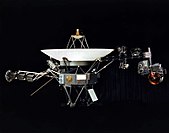
On 25 August, in Voyager 2's last planetary encounter, the spacecraft swooped only 4,950 km (3,080 mi) above Neptune's north pole, the closest approach it had made to any body since it left
The exploration mission revealed that Neptune's atmosphere is very dynamic, even though it receives only three percent of the sunlight that Jupiter receives. Winds on Neptune were found to be the strongest in the Solar System, up to three times stronger than Jupiter's and nine times stronger than the strongest winds on Earth. Most winds blew westward, opposite the planet's rotation. Separate cloud decks were discovered, with cloud systems emerging and dissolving within hours and giant storms circling the entire planet within sixteen to eighteen hours in the upper layers. Voyager 2 discovered an anticyclone dubbed the Great Dark Spot, similar to Jupiter's Great Red Spot. However, images taken by the Hubble Space Telescope in 1994 revealed that the Great Dark Spot had disappeared.[7] Also seen in Neptune's upper atmosphere was an almond-shaped spot designated D2 and a bright, quickly moving cloud high above the cloud decks dubbed "Scooter".[4][8]
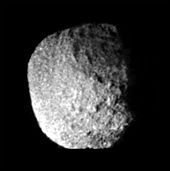
The fly-by of the Neptunian system provided the first accurate measurement of Neptune's mass, which was found to be 0.5 percent less than previously calculated. The new figure disproved the hypothesis that an undiscovered
Neptune's
Voyager 2 discovered six new small moons orbiting Neptune's equatorial plane, dubbed
A list of previous and upcoming missions to the outer Solar System can be found at the List of missions to the outer planets article.
Possible future missions
As of February 2024[update], there are no approved future missions to visit the Neptunian system.
After the Voyager flyby, NASA's next step in scientific exploration of the Neptune system was considered to be a
Several mission concepts have been developed to visit the Neptune system, including:
- CNSA designed to explore the heliosphere. The second would fly by Neptune in 2038 at a distance of 1,000 km and drop an atmospheric probe en route to the tail of the heliosphere.[14]
- OSS mission — A proposed collaborative flyby mission by ESA and NASA. Its main focus would be to map the gravitational fields in deep space, including the Outer Solar System (up to 50 AU).[17]
- large strategic science mission (LSSM) by NASA that would launch in 2033 and arrive at Neptune in 2049.[21]
- Triton Ocean Worlds Surveyor would be a less capable version of Odyssey without the atmospheric probe. Launching in 2031 and arriving in 2047, it would be baselined for the lower-cost New Frontiers program rather than the LSSM class.[22]
- Arcanum — A Neptune-orbiting mission comprising Somerville (named for Mary Somerville) and a Triton lander Bingham (named for Hiram Bingham III), with an unusual added purpose to Somerville, acting as a space telescope at apoposeideum. A secondary intent is to prove the technology behind the newest super heavy-lift launch vehicles, primarily the SpaceX Starship.[23]
- Argo — A cancelled mission concept in the New Frontiers program, a flyby mission to visit Jupiter, Saturn, Neptune (with Triton) and the Kuiper belt with launch in 2019.
- New Horizons 2 — A cancelled mission concept for a flyby mission to the Neptune system and Kuiper belt based on the New Horizons space probe.
- Nautilus — A Triton-focused Neptune orbiter baselined for the New Frontiers program, with launch in August 2042 and orbital insertion slated for April 2057.[24][25]
- Tianwen-5 — a long-term concept being developed by the China National Space Administration (CNSA), which could potentially arrive in 2058.[26]
The lowest-energy trajectory for a launch from Earth to Neptune uses a Jupiter gravity assist, opening an optimal launch window with a 12-year interval, when Jupiter is in a favourable position relative to the Earth and Neptune. An optimal launch window was open for such a Neptune mission from 2014 to 2019, with the next opportunity occurring from 2031.[27] These constraints are based on the requirement of a gravity assist from Jupiter. With the new Space Launch System (SLS) technology in development at Boeing, deep space missions with heavier payloads could potentially be propelled at much greater speeds (200 AU in 15 years) and missions to the outer planets could be launched independently of gravity assistance.[28][29]
Scientific studies from afar
Space telescopes such as the Hubble Space Telescope have signified a new era of detailed observations of faint objects from afar, across the entire
See also
- Exploration of Mercury
- Exploration of Venus
- Exploration of Mars
- Exploration of Jupiter
- Exploration of Saturn
- Exploration of Uranus
Notes
- ISSN 0035-8711.
References
- ^ "China to launch a pair of spacecraft towards the edge of the solar system". 16 April 2021.
- Bibcode:2003DPS....35.2002D.
- ISBN 9780387493268.
- ^ JPL. Retrieved 3 March 2016.
- ^ ISBN 9780387493268.
- ^ See the "Neptune" page from JPL.
- ^ "Hubble Discovers New Dark Spot on Neptune". Hubblesite.org. NASA. 19 April 1995. Retrieved 4 March 2016.
- ^ See "Neptune:In Depth" from NASA.
- ISBN 978-0-8027-1363-6.
- ^ Chris Gebhardt; Jeff Goldader (August 20, 2011). "Thirty-four years after launch, Voyager 2 continues to explore". NASASpaceflight.
- ^ a b Clark, Stephen (25 August 2015). "Uranus, Neptune in NASA's sights for new robotic mission". Spaceflight Now. Retrieved 7 September 2015.
- ^ "Solar System Exploration" (PDF). Science Mission Directorate (NASA). September 2006. Retrieved 5 August 2015.
- ^ "Planetary Science Decadal Survey, JPL Rapid Mission Architecture, Neptune-Triton-KBO Study Final Report" (PDF). NASA. February 2010. Retrieved 5 August 2015.
- ^ "China Considers Voyager-like Mission to Interstellar Space".
- ^ "Origins, Dynamics and Interiors of Neptunian and Uranian Systems". Retrieved 5 August 2015.
- ^ "Astronomers Make the Case for a Mission to Neptune and Uranus". The Physics arXiv Blog. arXiv. 17 February 2014. Retrieved 5 August 2015.
- S2CID 55295857.
- ^ Steven Oleson (7 May 2015). "Triton Hopper: Exploring Neptune's Captured Kuiper Belt Object". NASA Glenn Research Center. Retrieved 11 February 2017.
- ^ "Neptune's Moon Triton Is Destination of Proposed NASA Mission". New York Times. 2019-03-19. Retrieved 27 March 2019.
- ^ Potter, Sean (2 June 2021). "NASA Selects 2 Missions to Study 'Lost Habitable' World of Venus" (Press release). NASA. Retrieved 2 June 2021.
- ^ Abigail Rymer; Brenda Clyde; Kirby Runyon (August 2020). "Neptune Odyssey: Mission to the Neptune-Triton System" (PDF). Archived from the original (PDF) on 15 December 2020. Retrieved 18 April 2021.
- ^ Hansen-Koharcheck, Candice; Fielhauer, Karl (7 June 2021). "Triton Ocean Worlds Surveyor concept study" (PDF). NASA.
- arXiv:2106.09409.
- ^ Steckel, Amanda; Conrad, Jack William; Dekarske, Jason; Dolan, Sydney; Downey, Brynna Grace; Felton, Ryan; Hanson, Lavender Elle; Giesche, Alena; Horvath, Tyler; Maxwell, Rachel; Shumway, Andrew O; Siddique, Anamika; Strom, Caleb; Teece, Bronwyn; Todd, Jessica; Trinh, Kevin T; Velez, Michael A; Walter, Callum Andrew; Lowes, Leslie L; Hudson, Troy; Scully, Jennifer E. C. (12 December 2023). "The Science Case for Nautilus: A Multi-Flyby Mission Concept to Triton". AGU. Retrieved 11 January 2024.
- ^ "Planetary Science Summer School · Jason Dekarske". Jason Dekarske. December 19, 2023. Retrieved January 25, 2024.
- ^ "China's plans for outer Solar System exploration". The Planetary Society. 21 December 2023. Retrieved 18 April 2024.
- ^ Candice Hansen; et al. "Argo - A Voyage Through the Outer Solar System" (PDF). SpacePolicyOnline.com. Space and Technology Policy Group, LLC. Archived from the original (PDF) on 24 September 2015. Retrieved 5 August 2015.
- ^ "Space Launch Mission" (PDF). The Boeing Company. 2013. Archived from the original (PDF) on 23 September 2015. Retrieved 6 August 2015.
- ^ William Harwood (3 July 2014). "NASA finalizes $2.8 billion Boeing contract for SLS rocket stage". CBS News. Retrieved 6 August 2015.
- ISBN 978-0-521-85604-1.
- ^ Nemiroff, R.; Bonnell, J., eds. (18 February 2000). "Neptune through Adaptive Optics". Astronomy Picture of the Day. NASA.
- ^ First Ground-Based Adaptive Optics Observations of Neptune and Proteus Planetary & Space Science Vol. 45, No. 8, pp. 1031–1036, 1997
Sources
- Neptune Voyager 2 – The Interstellar Mission, Jet Propulsion Laboratory, California Institute of Technology
- Neptune: In Depth Planets, NASA
External links
- 25 Years After Neptune: Reflections on Voyager NASA Voyager website
- Images of Neptune and All Available Satellites Photojournal, JPL

